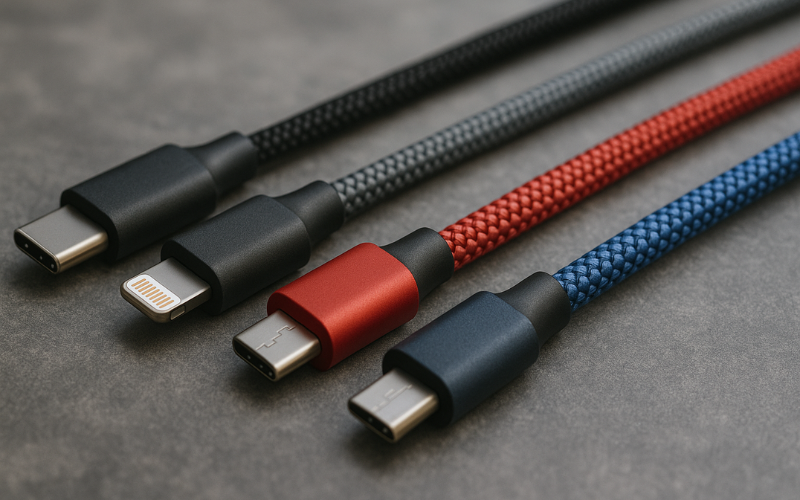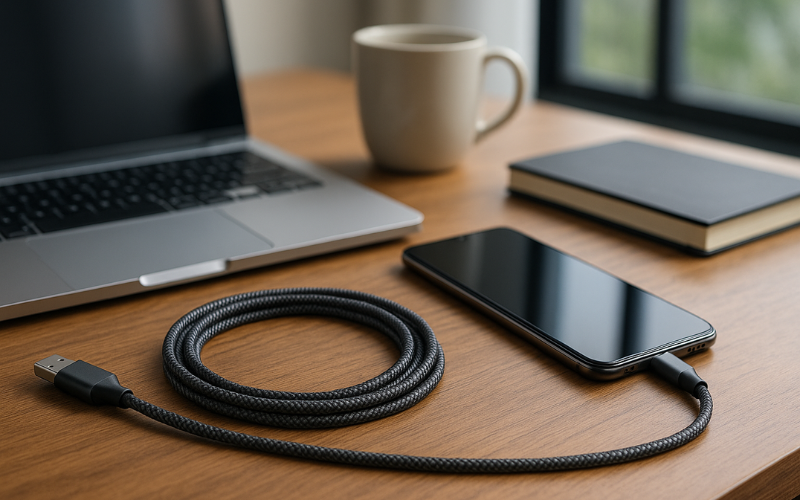Braided Charging Cable: Benefits, Types & Buying Tips
A braided charging cable is a USB cable encased in a tightly woven nylon or fabric mesh, instead of the traditional plastic or rubber covering. This makes it more durable, flexible, and stylish compared to regular charging cables.
While the internal wiring remains similar to standard cables, the braided exterior acts as a protective shell that reduces fraying, resists tangling, and extends the cable’s life span. Whether you’re charging a smartphone, tablet, or other USB-powered device, a braided cable often outperforms standard ones in both functionality and design.
Why Are Braided Cables Better Than Standard Cables?
Braided charging cables stand out due to a range of performance and durability advantages:
Key Benefits:
- Tangle Resistance: The textured braided surface resists knotting.
- Improved Longevity: Fabric mesh protects against bending and wear.
- Aesthetic Appeal: Comes in stylish patterns and colors.
- Stronger Build: Enhanced reinforcement reduces internal wire breakage.
- Heat & Abrasion Resistance: Ideal for daily heavy usage.
In contrast, standard plastic-coated cables often crack or fray near the connectors, especially with frequent unplugging or coiling. Braided cables offer a clear edge when it comes to both durability and user experience.
How Braided Charging Cables Are Made
Braided cables feature two main layers: the core wiring and the braided sheath. Here’s how it typically works:
Construction Overview:
| Component | Description |
| Internal Wires | Copper or tinned copper for power & data transmission |
| Insulation Layer | Protects wires from overheating and short circuits |
| Braided Jacket | Woven nylon or PET mesh for durability and flexibility |
| Reinforced Joints | Often feature silicone or rubber sleeves for extra support |
This structure ensures that even under pressure, pulling, or twisting, the cable remains functional and intact. Some premium braided cables also come with Kevlar fibers for extreme toughness.
Types of Braided Charging Cables
Not all braided cables are the same. They come in various formats to suit different devices and purposes.
Common Types:
- USB-A to USB-C: For Android phones, tablets, and laptops.
- USB-A to Lightning: For Apple devices like iPhones and iPads.
- USB-C to USB-C: Common for newer Androids, MacBooks, and fast charging.
- USB-A to Micro-USB: For older phones, power banks, cameras, and gamepads.
Specialized Variants:
- Fast Charging Cables: Support higher wattage (18W to 100W).
- Magnetic Braided Cables: Easily detachable connectors.
- 3-in-1 Braided Cables: Offer Lightning, USB-C, and Micro-USB heads in one cord.
When choosing, make sure the cable matches your device’s port and power requirements.
Benefits of Using Braided Charging Cables Daily
Using a braided cable every day can make a noticeable difference, especially for users who are always on the go. Here’s why it’s a practical upgrade:
- Longer Life Cycle: Handles thousands of bends and plug-ins.
- Better Grip and Feel: The braided exterior is smooth yet secure to hold.
- Reliable Charging: Less likely to lose connection or cause slow charging.
- Portable and Travel-Friendly: Doesn’t get tangled in bags or pockets.

A good braided cable can last up to 5 times longer than a regular plastic one, saving you money and hassle in the long run.
What to Look for When Buying a Braided Cable
To avoid low-quality imitations, pay attention to the following features when buying:
Must-Have Features:
- Certification: MFi certified for Apple devices; USB-IF certified for others.
- Reinforced Connectors: Look for strain relief near plugs.
- Data Transfer Speed: Ensure it supports USB 3.0 or above if needed.
- Charging Capacity: Fast charging support (18W, 30W, or higher).
- Length Options: Choose from 1ft to 10ft depending on use case.
Some brands even offer lifetime warranties, which speaks volumes about their confidence in product quality.
Braided vs Non-Braided Cable: A Side-by-Side Comparison
Let’s break it down in a quick comparison table:
| Feature | Braided Cable | Regular Cable |
| Durability | High – withstands wear and tear | Low – prone to fraying or splitting |
| Tangle Resistance | Excellent | Poor |
| Aesthetic Appeal | Stylish & colorful | Basic and plain |
| Cost | Slightly more expensive | Cheaper upfront |
| Life Span | 1–3 years or more | 6–12 months on average |
Overall, the slight cost premium of a braided cable pays off through fewer replacements and better reliability.
Best Use Cases for Braided Cables
Braided charging cables aren’t just for daily phone charging. Their versatility makes them a great choice for many scenarios:
Ideal Use Cases:
- Gaming setups: Especially for wired controllers or VR headsets.
- Car chargers: Won’t tangle or fray from heat and use.
- Work-from-home setups: Adds durability and clean aesthetics.
- Travel: Easily packs without tangling.

They’re particularly useful for power users like gamers, content creators, and professionals who require stable and fast charging across multiple devices.
Are There Any Downsides to Braided Cables?
While they’re superior in many ways, braided cables do have a few considerations:
- Stiffer than plastic cables: They might not be as bendable in tight spaces.
- Slightly thicker: May not fit well in ultra-slim cases or ports.
- Cost factor: Quality braided cables can be more expensive upfront.
However, most users find that the durability and style of braided cables make these minor trade-offs worth it.
Should You Buy a Braided Charging Cable?
Absolutely a braided charging cable is a smart investment for anyone who wants a reliable, long-lasting, and stylish charging solution. Whether you need a backup cord, a daily driver, or a travel-friendly option, braided cables consistently outperform standard ones in nearly every category.
Look for trusted brands, verify certifications, and match the cable to your power needs. With a little research, you can find a braided cable that not only lasts but enhances your everyday tech experience.
Leave a reply